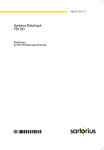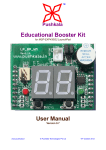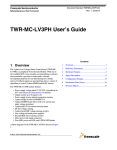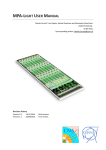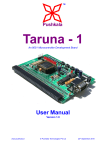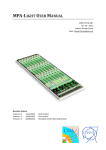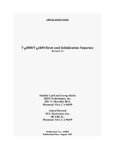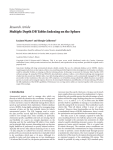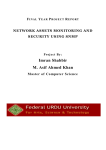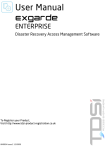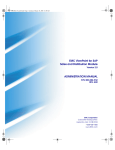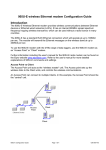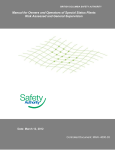Download R4000 Slew Rate Control Logic for Output Buffers
Transcript
APPLICATION NOTE MIPS R4000 Slew Rate Control Logic for Output Buffers Shabbir Latif MIPS Technologies, Inc. 2011 N. Shoreline Blvd. P. O. Box 7311 Mt. View, CA 94039-7311 Publication No.: AP001 Publication Date: July, 1992 MIPS Technologies, Inc. reserves the right to make changes to any products herein at any time without notice in order to improve function or design. MIPS does not assume any liability arising out of the application or use of any product or circuit described herein; neither does it convey any license under patent rights nor imply the rights of others. Copyright 1992 by MIPS Technologies, Inc. No part of this document may be reproduced in any form or by any means without the prior written consent of MIPS Technologies, Inc. R4000 and R4400 are registered trademarks of MIPS Technologies, Inc. The R4000 /R4400 is available from the following manufacturers: Integrated Device Technology, Inc. (Attention - RISC Microprocessor Marketing) 2975 Stender Way Santa Clara, CA 95052-8015 Tel: (408) 727 6116 LSI Logic Corporation (Attention - MIPS Division) 1551 McCarthy Blvd. Milpitas, CA 95035 Tel: (408) 433 8000 NEC Corporation (Attention - Microcomputer Division) 401 Ellis St. Mountain View, CA 94039 Tel: (415) 960-6000 Performance Semiconductor Corporation (Attention - Microprocessor Marketing) 610 E. Weddell Drive Sunnyvale, CA 94089 Tel: (408) 734 9000 Siemens Components Inc. (Attention - Integrated Circuit Division) 10950 Tantau Ave. Cupertino, CA 95014 Tel: (408) 777-4500 Toshiba Corporation 9740 Irvine Blvd. Irvine, CA 92713 (714) 583-3000 Table of Contents 1. Overview ..................................................................................................5 2. Slew Rate Control for the Output Buffers in R4000 ..........................6 3. How to Set the “Drive off Delay” .........................................................9 4. Examples.................................................................................................13 Example 1 ..................................................................................................13 Example 2 ..................................................................................................13 Example 3 ..................................................................................................14 Example 4 ..................................................................................................14 5. Summary ................................................................................................15 6. References...............................................................................................16 7. Reader’s Comments ..............................................................................17 R4000 - Slew Rate Control Logic for the Output Buffers R4000 - Slew Rate Control Logic for the Output Buffers Overview 1 One of the largest causes of variation in voltage or noise on the GND and VCC supplies is the switching of the Output Buffers. This variation in supply voltages has two causes: • the large number of buffers that can switch at the same time • each buffer driving a large external load Noise can be calculated using the formula V = L( ∆i/ ∆t) where V is the noise on the supplies, L is the inductance of the supply pin, bonding wire, etc., and ∆i/ ∆t is the rate at which the current changes; this term is directly related to how fast the load capacitor is charged or discharged by the output drivers of the microprocessor. The above variation or noise on the GND and VCC supplies can be reduced by increasing the rise and fall times of the output drive. Although this reduces the ∆i/ ∆t term, it also increases the propagation delay time of the output signal to its destination and care must be taken to ensure the resulting delay meets system design requirements. R4000 - Slew Rate Control Logic for the Output Buffers 5 Slew Rate Control for the Output Buffers in R4000 2 The R4000 has Slew Rate Control Logic with a negative feedback loop that adjusts the output buffer drive (or slew rate) so that the output buffer is fast enough to meet the system’s speed requirement, and no more, in order to minimize the noise for that particular system. As shown in Figure 1, the feedback loop includes path (A) from pins IO_Out to IO_In . This path represents the signal path with the longest delay from the R4000 to any other external register which matches the load and the transmission line effect on the PCB (see Reference 1). The Slew Rate Control Logic drives a signal through the IO_Out output buffer and, using a selectable clock, samples the return signal on the IO_In pin. If the signal arrives earlier than the maximum acceptable delay, which is selected by the designer, the Slew Rate Control Logic slows the speed of the IO_Out output buffer; if the signal arrives later, it speeds up the IO_Out output buffer. 6 R4000 - Slew Rate Control Logic for the Output Buffers Other Output Buffers Mode Bits<62:61> EnblDPLL, EnblDPLLR Mode Bits<52:50> Drv0_50,Drv0_75,Drv1_00 Mode Bits<60:53> InitP, InitN R4000 Path B: Path with the longest delay R E G X_Out X X_In R E G IO_In RClk SampleClk Path A: Path matched to the path with the longest delay. CntN<3:0> CntP<3:0> Slew Rate Control R E G IO_Out SClk Figure 1: Overview of the Slew Rate Control Mechanism in R4000 The Slew Rate Control Logic uses the signals CntN<3:0> and CntP<3:0> to control the N-channel and the P-channel devices, respectively, of the predrivers to the final stage of the output buffers. This allows CntN<3:0> signals to adjust the rising edge of the outputs and CntP<3:0> to adjust the falling edge, giving 16 independent states of control in each direction. All ones on CntN<3:0> provides the fastest pullup rate and all zeros on CntP<3:0> provides the fastest pulldown rate. The variation in the least significant bit (LSB), CntN<0> or CntP<0> , provides the smallest resolution. Note that there is always some jitter at the output due to the fact that the control mechanism is continuously trying to converge to the programmed maximum adjustable delay value by switching the state of the LSBs CntN<0> and CntP<0> . The signals, CntN<3:0> and CntP<3:0> , that control the output buffer for IO_Out pin also control the output buffers for the rest of the pins of the R4000. Thus, the slew rate of the rest of the output buffers will vary in the same manner as the variation of the IO_OUT buffer; however, the amount of variation will depend on the external loading on each pin. The R4000 has three modes for controlling the slew rates of the output buffers and in turn minimizing the noise caused by ∆i/ ∆t. As shown in Table 1, these three modes are selected by Mode Bits<62:61>, EnblDPLL and EnblDPLLR , respectively. R4000 - Slew Rate Control Logic for the Output Buffers 7 Table 1: Modes of Operation for Controlling the Slew Rate EnblDPLL EnblDPLLR Modes of Operation 0 0 Keep the slew rate of the output drivers fixed as set by the Mode Bits<60:57> and <56:53>, programmed during boot time. 0 1 Enable the mechanism to dynamically control the slew rate only during ColdReset and thereafter retain the slew rate of the output drivers. 1 X (don’t care) Enable the mechanism to dynamically control the slew rate during ColdReset and Normal Operation. The first mode in Table 1, which keeps the slew rate of the output buffer fixed, is useful for the situation in which any jitter associated with the operation of the slew rate control mechanism cannot be tolerated, and the variation in temperature and supply voltage after ColdReset is expected to be small. To dynamically control the slew rate, either during the ColdReset operation or during both ColdReset and Normal operations, the R4000 does the following. 1. It uses Mode Bits<60:57> and <56:53> (also referred as InitP and InitN , respectively), programmed during the boot time, to set the initial values of CntN<3:0> and CntP<3:0> , which in turn sets the initial slew rate of the output buffers. 2. It uses the “drive-off” delay, programmed at boot time through Mode Bits <52:50> (Drv1_00 , Drv0_75 or Drv0_50 ), as the maximum acceptable delay of the data and, accordingly, selects the SampleClk to sample the IO_In as shown in Figure 1. Table 2 shows the truth table for Mode Bits<52:50>; the remaining combinations are reserved 3. It uses the path between IO_Out pin and IO_In pin, as described earlier. Table 2: The Truth Table for Mode Bits <52:50> , Setting Drive-off Delays Mode Drv1_00 Drv0_75 Drv_5 Drive-off time Dynamic 0 0 1 0.50*T(2) Dynamic 0 1 0 0.75*T(2) Dynamic 1 0 0 1.00*T(2) Fixed X X X Note 1 Notes: 1) The Fixed “Drive-off” Time Is Selected By Initn and Initp (Mode Bits<60:53>). 2) ‘T’ is the period of the Master clock (MasterClk). To make the programmed delay value independent of system clock frequency (MasterClk ), the delay value is specified in terms of a percentage of one cycle time instead of a constant. Also, note that this mechanism is not affected by the interface clocks divisor (Mode Bits<49:47>), it is always a fraction of one (MasterClk ) cycle. 8 R4000 - Slew Rate Control Logic for the Output Buffers How to Set the “Drive off Delay” 3 As mentioned in the previous section, for the dynamic control of the output buffer slew rate, R4000 uses the “drive off delay” programmed by Mode Bits<52:50> during boot time . This section explains how to determine the setting of these mode bits. In general, a path is selected (Path B in Figure 1) with the longest delay from the output pin to the output of the receiving data register (node X in Figure 1). Then, the transmission line effect and the capacitive loading of the IO_Out is matched with the transmission line effect and the capacitive loading of Path B (see Reference 1 for detail). Finally, after calculating at what time the SampleClk in the Path A should be, the appropriate Mode Bits<52:50> (Drv1_00 , Drv0_75 or Drv0_50 ) are selected. Figure 2 shows the Path A again and the corresponding timing diagram with all the delay components labelled. The equation of the delay TSS plus the clock jitter TSSj in terms of the output buffer delay (tDO) is also shown (Equation 1). TSS is the time from the rising edge of the SClk , which triggers the IO_Out, to the SampleClk edge which latches the IO_In at a selected time. TSSj is the jitter of the SampleClk with reference to the SClk. The TSSj could be both positive or negative; however, a positive number is chosen because, in this case its affect is worse than the affect of a negative number. tDOj is the jitter on the output caused by the slew rate control logic which is continuously trying to converge to the programmed “drive off” delay value by switching the state of the LSBs, CntN<0> and CntP<0> . Figure 3 shows Path B again and corresponding timing diagram with all the delay components labelled. This path is an example of a signal path from the R4000 to a receive-data register. This register could be part of external agent chip or an individual component on the PCB. The rising edge of SClk drives the data, and the rising edge of the RClkD latches the data into the register. TSR is the delay between the RClk and the SClk , TSRD is delay between the RClkD and the SClk and TSRj is the jitter on RClk or RClkD with respect to SClk . The TSRDj could be a positive or a negative number; however, a negative number chosen because , in this case, its affect is worse than the affect of a positive number. The equation of the delay time TSRD is shown in Equation 2 in Figure 3. R4000 - Slew Rate Control Logic for the Output Buffers 9 TSSj=Sample Clk Jitter tDOj= Output Jitter due to Slew Rate Control Logic tDO=SClk to IO_Out Delay tLi= Transmission Delay tDSi= Input Set Up time to R4000 OBUFF RECEIVER REG SAMPLE REG Transmission Line Q IO_Out Q1 IO_In IO_In1 Sample Clk (Depend on the mode bits<52:50>) SClk CntN<3:0> CntP<3:0> (Frequency of SClk < Frequency of MasterClk SClk (Frequency of SClk = Frequency of MasterClk) SClk TSS +TSSj Sample Clk tDOj IO_Out (The dotted waveforms show jitter only in one, worst case, direction) tDOj IO_In tDO tLi tDSi Eq 1: TSS+ TSSj = tDO+ tLi + tDSi Figure 2: Path from pins IO_Out to IO_In. 10 R4000 - Slew Rate Control Logic for the Output Buffers tDOj= Output Jitter due to Edge Control Logic TSRj= Clock Jitter tLx= Transmission Delay tDO= SClk to X_Out Delay tDSx= Input Set Up time to ext.logic Receiver OBuff REG Q REG Transmission Line X_In X_In1 X_Out SClk RClkD CntN<3:0> CntP<3:0> tRD = Delay between RClk and RClkD R4000 Transmission Line RClk Logic on the PCB SClk TSR-TSRj tRD RClk TSRD-TSRj RClkD tDOj X_Out tDO tLx (dotted waveforms show jitter only in one, worst case direction) X_In tDSx Eq 2: TSRD-TSRj = tDO+ tDOj + tLx + tDSx Figure 3: Representative Worst Case Path from R4000 to External Component R4000 - Slew Rate Control Logic for the Output Buffers 11 X If the capacitive load and the transmission line between the pins IO_Out and IO_In are matched with the loading and the transmission line between X_Out and X_In , then the output buffer delay, tDO, is equal in both the paths, and tLi = tLx. Thus, deriving tDO from the Equation 2 and substituting into the equation Equation 1, TSS can be derived to decide which of the Mode Bits Drv1_00 , Drv0_75 , or Drv0_50 needs to be selected. Eq 3: DrvX_XX < TSS = TSRD - TSRj-tSSj + tDSi-tDSx - tDOj 12 R4000 - Slew Rate Control Logic for the Output Buffers Examples 4 The following examples show how to set Mode Bits <52:50>. Example 1 In a system with SysCkRatio (Mode bits<17:15>) set to 0 (Ref: 1) , the frequency of RClk is equal to the frequency of MasterClk . If the delay, equal to the delay between RClk and RClkD , is added between SyncIn pin and SyncOut pin, the RClkD is locked to the MasterClk . But since RClkD leads SCLk and MasterClk by 0.25*T; this means, TSRD is (0.75*T). The R4000 AC specification (Ref.1) shows clock jitter = 0.5 ns, data set up time = 5.0 ns, and tDOj = 1 ns. Assuming tDSX = 7 ns, Equation 3 can be rewritten as: Eq 4: TSS = (0.75*T) - 0.5ns - 0.5ns + 5 ns - 7ns - 1ns = 0.75*T - 4ns Thus, for a 50 MHz system, TSS would be 11 ns; so Drv0_50 would be set to 1. Example 2 In a system with SysCkRatio (Mode bits<17:15>) set to 0, the frequency of the RClk is equal to the frequency of MasterClk . If the Sync_In pin is shorted to the SyncOut pin, the RClk is locked to the MasterClk . Since RClk leads SClk and MasterClk by 0.25*T; this means, TSRD is equal to (0.75*T + tRD), where tRD is the delay between RClk and RClkD . Thus, Equation 4, from Example 1, can be rewritten as, TSS = (0.75*T + tRD) - 4ns If tRD > 4ns then TSRD could be > (0.75*T+4ns), making TSS > 0.75*T; in which case Drv0_75 is set to 1. R4000 - Slew Rate Control Logic for the Output Buffers 13 Example 3 In a system with SysCkRatio set to 1, the frequency of RClk is two-thirds the frequency of MasterClk , so TSRD is equal to (1.0*T) given in Example 1, and TSRD is greater than (1.0*T) given in Example 2. Thus, in the first example Drv0_75 is set to 1, and in the second example Drv1_00 is set to 1. Example 4 Similarly, in the system with the SysCkRatio set to 2, the frequency of RClk is half the frequency of MasterClk ; so Drv1_00 is set to 1 in Examples 1 and 2. 14 R4000 - Slew Rate Control Logic for the Output Buffers Summary 5 The R4000 has Slew Rate Control Logic with negative feedback loop that adjusts the output buffer drive so that the output buffer is only fast enough to meet the system’s speed requirement, and no more, in order to minimize the noise for that particular system. The maximum acceptable delay is programmed at the boot time using the “drive-off” Mode Bits<52:50> (Drv1_00 , Drv0_75 or Drv0_50 ). It also provides the flexibility to select whether to enable the control only during the ColdReset time, or during the ColdReset time and the Normal operation, or to select a fixed slew rate as programmed by the Mode Bits<60:53> (InitP and InitN ). Some examples were shown in this document on how to select the “drive-off” delay mode bits. R4000 - Slew Rate Control Logic for the Output Buffers 15 References Reference 1: MIPS R4000 Processor Interface Specification Reference 2: MIPS R4000 Microprocessor User’s Manual 16 R4000 - Slew Rate Control Logic for the Output Buffers Reader’s Comments Please FAX your comments about this document to: Anjaneya Thakar Fax: (415) 390-6170 Address: 2011 N. Shoreline Blvd., P.O. Box 7311, Moutain View, CA 94039-7311 Areas of Improvement: Errors: Reader Information: Name: Company: Address: Phone: FAX: Thank you for your feedback. R4000 - Slew Rate Control Logic for the Output Buffers 17

















